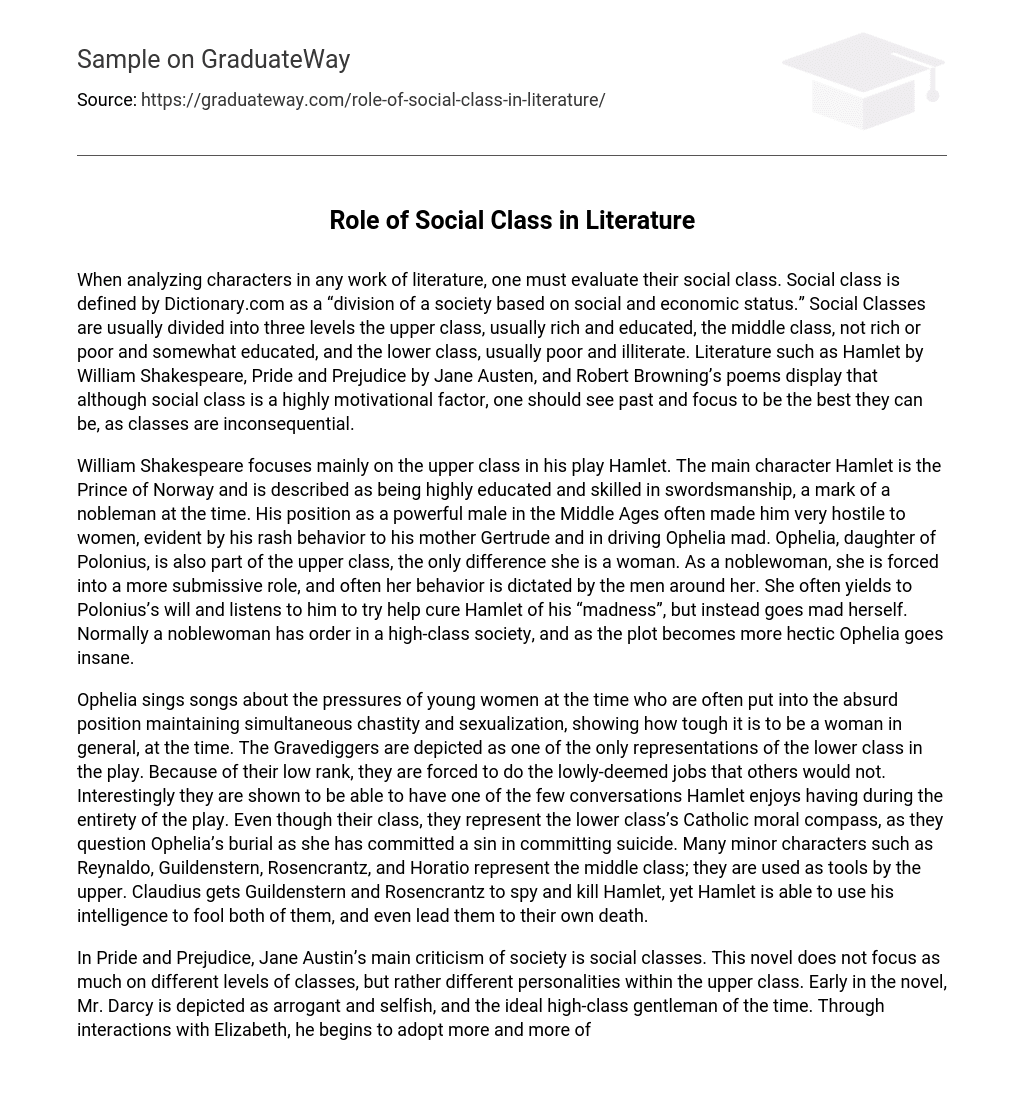When analyzing characters in any work of literature, one must evaluate their social class. Social class is defined by Dictionary.com as a “division of a society based on social and economic status.” Social Classes are usually divided into three levels the upper class, usually rich and educated, the middle class, not rich or poor and somewhat educated, and the lower class, usually poor and illiterate. Literature such as Hamlet by William Shakespeare, Pride and Prejudice by Jane Austen, and Robert Browning’s poems display that although social class is a highly motivational factor, one should see past and focus to be the best they can be, as classes are inconsequential.
William Shakespeare focuses mainly on the upper class in his play Hamlet. The main character Hamlet is the Prince of Norway and is described as being highly educated and skilled in swordsmanship, a mark of a nobleman at the time. His position as a powerful male in the Middle Ages often made him very hostile to women, evident by his rash behavior to his mother Gertrude and in driving Ophelia mad. Ophelia, daughter of Polonius, is also part of the upper class, the only difference she is a woman. As a noblewoman, she is forced into a more submissive role, and often her behavior is dictated by the men around her. She often yields to Polonius’s will and listens to him to try help cure Hamlet of his “madness”, but instead goes mad herself. Normally a noblewoman has order in a high-class society, and as the plot becomes more hectic Ophelia goes insane.
Ophelia sings songs about the pressures of young women at the time who are often put into the absurd position maintaining simultaneous chastity and sexualization, showing how tough it is to be a woman in general, at the time. The Gravediggers are depicted as one of the only representations of the lower class in the play. Because of their low rank, they are forced to do the lowly-deemed jobs that others would not. Interestingly they are shown to be able to have one of the few conversations Hamlet enjoys having during the entirety of the play. Even though their class, they represent the lower class’s Catholic moral compass, as they question Ophelia’s burial as she has committed a sin in committing suicide. Many minor characters such as Reynaldo, Guildenstern, Rosencrantz, and Horatio represent the middle class; they are used as tools by the upper. Claudius gets Guildenstern and Rosencrantz to spy and kill Hamlet, yet Hamlet is able to use his intelligence to fool both of them, and even lead them to their own death.
In Pride and Prejudice, Jane Austin’s main criticism of society is social classes. This novel does not focus as much on different levels of classes, but rather different personalities within the upper class. Early in the novel, Mr. Darcy is depicted as arrogant and selfish, and the ideal high-class gentleman of the time. Through interactions with Elizabeth, he begins to adopt more and more of Elizabeth’s point of view that one does not have to define themselves to their class. Darcy and Elizabeth refuse to subject to the social boundaries that others such as Lady Catherine have completely enveloped their lives around. The comical Mr. Collins and scheming Caroline Bingley exemplify those whose personalities and actions are defined by their class system. Elizabeth uses Mr. Bingley and the Gardiners to highlight focusing on the other person’s character rather than their social class. Mr. Bingley is one of the wealthiest characters in the novel yet places nearly no weight on social standing while the Gardiners are very caring and generous, as Mrs. Gardiner might be more of a mother to Elizabeth and Jane than their actual mother. Austen uses Elizabeth to convey social classes as valid but also highlights through Darcy growth that classes do not determine one’s character.
Robert Browning uses his poems to show the different impacts death have on social class. The man of lower class rank in “Porphyria’s Lover” believes Porphyria will return to the order of society, so grants her the wish to be with him. He strangles her with her “yellow” (symbolic for gold or upper class) hair so they can be together forever. Browning removes social class altogether, showing that through death, class is hollow. Browning’s “My Last Duchess” describes the Duke killing his wife because she was unable to fulfill her social expectations. Her death was justified because she was “too easily impressed” and would look at everyone. He also tries to use his family name of nine-hundred years to show the prestige of his name and class. The Duke compares him killing his Duchess to the god Neptune taming the wild beast that is the sea-horse, necessary and that he is godlike. Although the Duke killed her, he uses his social standing to have someone else to kill her, once again showing how the upper class uses lower classes. He must protect his family name and reputation and blames the duchess inability to change rather than his own misgivings.
When Shakespeare, Austen, and Browning wrote their literature, they brought attention to the theme of social class and its impact on a person. Social classes seem to be motivating factors for people to live by, but those who can see past class and judge a person for themselves are better for it. And while social classes exist, concepts such as death make social class seem foolish to even think about.





